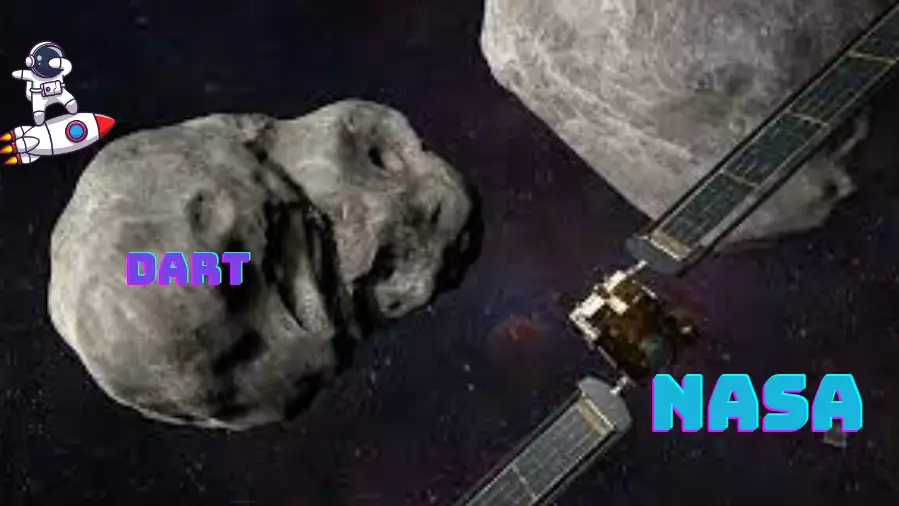NASA has launched the first-ever spacecraft designed to intercept and smack an asteroid with a glancing blow, providing valuable information that could help protect Earth from similar impacts in the future. The agency’s Double Asteroid Redirection Test (DART) will attempt to slow down an approaching space rock called Didymos B, which orbits its larger companion, Didymos A, about five times every two hours.
What Is DARTS?
DARTS is NASA’s Double Asteroid Redirection Test, or the first of its kind mission to demonstrate what we could do if a real asteroid threat were detected. The spacecraft will show us how we can push away, or deflect, asteroids that might collide with Earth. DART uses kinetic impactor technology–a collision from DART’s high-speed flyby on February 14, 2021 at 10 miles per second will change the orbit of asteroid Didymos B (its moon) by up to 8 feet per second. The final target is Didymos A (its parent), which it will use as a gravitational assist and return closer to Earth for more detailed study.
The mission (phases)
Launch NASA DART spacecraft into Earth orbit on November 1, 2020. – The spacecraft will fly within 3 miles of the asteroid in October 2022, firing its kinetic impactor at it. – The kinetic impactor will slow the asteroid down by about one-sixth of a mile per hour. This is enough to divert it from its course around earth and onto a new course that would not intersect with our planet’s orbit. And then? NASA will track the new trajectory for decades to come. If necessary, another kinetic impactor could be sent to the asteroid later this century. But if all goes well, the mission will prevent any potential future collision with earth.
When will the asteroid hit Earth?
The DART spacecraft is set to crash into the asteroid in 2020. The collision should change its orbit, but not enough for it to hit Earth. If this mission is successful, NASA hopes to use these techniques on asteroids that are found to be on track to collide with our planet.
When will the asteroid hit Earth?
The craft has been developed by engineers at the Johns Hopkins Applied Physics Lab (APL). It will be traveling at seven times faster than a bullet and could destroy a city if it misses its target. But instead of destroying it, the idea is to ram into one side of it hard enough so that it changes course. It will also be equipped with technology to send back data from the surface of the asteroid so scientists can learn more about them. Scientists believe asteroids like Bennu may have delivered life-giving water and organic molecules when they slammed into early Earth.
How much damage could this do?
The spacecraft is designed to deflect the asteroid from its present course, which would result in it passing close enough for Earth that it could cause major damage. If deflected, the asteroid would pass about 6 million miles from Earth, or about 15 times farther than the moon. After doing this, NASA will follow up with ground-based telescopes to determine if DART has actually changed the path of the asteroid.
The DART mission is just one of many NASA missions underway at any given time.
In 2017 alone, we’ve sent 4 missions into space and have more planned for 2018 and beyond.
What are my chances of getting hit?
In the event that Earth is in danger, NASA will launch the Double Asteroid Redirection Test (DART) mission. The spacecraft would hit the asteroid, altering its course and velocity so that it will miss our planet. Scientists are confident that DART has enough juice to do the job–it will have about 1,500 times more kinetic energy than was unleashed by the atomic bomb dropped on Hiroshima.
Should we try to deflect other asteroids in advance?
There are many asteroids that we know about, but there are also many that we have yet to see. The DART mission is part of NASA’s plan for the future and they hope to get funding for it in their 2019 budget. If successful, this mission would be the first time that humanity has ever deliberately crashed a spacecraft into an asteroid.
The main reason why scientists want to deflect asteroids is because they may one day pose the risk of collision with Earth. In 2008, an asteroid came very close to colliding with our planet. Had it hit our planet, the impact could have killed 1 billion people or more.
Can we use this as a stepping stone towards other missions?
It is likely that the idea of NASA sending a spacecraft to smack an asteroid isn’t your first thought when it comes to the space agency’s future. However, this week NASA announced they are spending $78 million on their mission, which is called the Double Asteroid Redirection Test or DART. The goal of this project is to demonstrate how we can protect Earth from dangerous asteroids, according to Wired.
![]()
